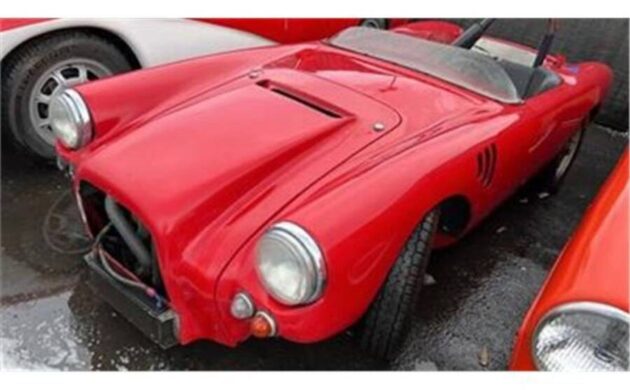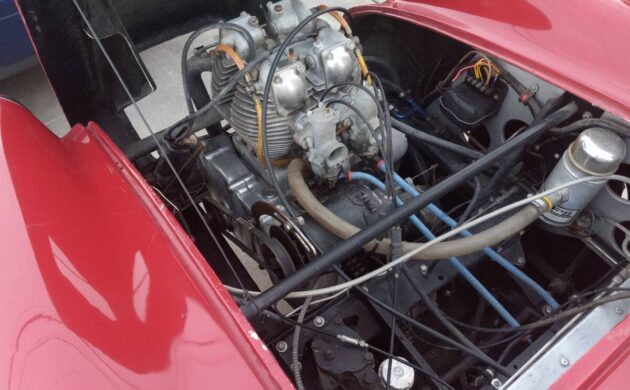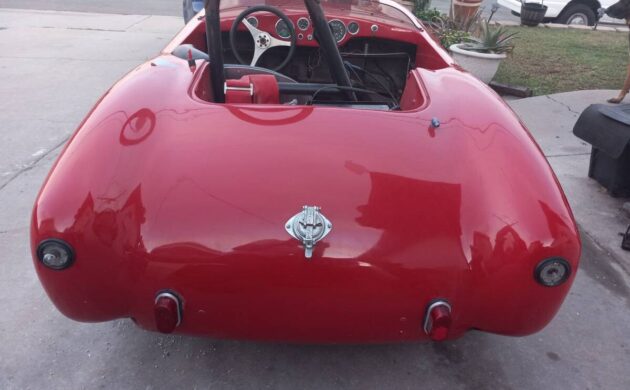Berkeley Coachworks, run by Charles Panter, was diligently making fiberglass caravans (travel trailers) in Biggleswade, Bedfordshire but its bean counters were broadcasting that all was not well with its accounts. The business was too seasonal. Panter appealed to Lawrence “Lawrie” Bond, father of the Bond Microcar: could he help Berkeley make a fiberglass sports car, perhaps to race in the 750 cc class? Berkeley was adept at using fiberglass, and at the time, Britain was having a love affair with motorcycle-engined cars: Frisky, Fairthorpe, Scootacar, and of course Lawrie’s own Bond … If Berkeley could add a car to its repertoire, that might help it financially. The first Berkeley motor car was on the road in 1956, the Anzani-powered SA322, then came the Excelsior-motored cars, with 18 and 30 bhp, and finally the Royal Enfield series, with a storming 40 bhp. Here on craigslist is one of these “big block” cars, a 1960 Berkeley B95 kitted out for vintage racing, with an asking price of $13,500. This car is in San Diego, California. Matt R. brought us this tip – thanks Matt! Fewer than 200 B95s were produced and just about half were given left-hand drive for export.
The Royal Enfield motor is an air-cooled four-stroke displacing 692 cc’s. As noted, the horsepower rating was about 40 and the car could make it to 80 mph. A duplex chain drove the differential; these had a habit of breaking. The transmission was originally an Albion four-speed manual; the notchy shift tunnel is visible here. This car’s engine has been rebuilt with Carillo rods and electronic ignition. The work shows; the engine bay is clean as a whistle. Unfortunately, while the motor is free, it is not currently running. The tall grille opening was designed to clear the larger Enfield motor; prior designs were more graceful. This frontal view shows an exterior oil cooler. The seller says the tires are brand new.
Berkeley interiors were sparse at best; this race car has even fewer accouterments. The car has a fire suppression system, a five-point harness, and a race seat. The battery has been relocated behind the driver. It does have a rollbar, but with an aluminum frame and a fiberglass body, those anchor points for the rollbar should be checked. Ditto on the harness. And if a buyer does want to take it racing, some components will have to be refreshed or rebuilt; check your local vintage race organization’s rules.
What does a Berkeley race against these days? Crosleys, Turners, other microcars. Here’s the view they should see. This is a committed race car: it would be difficult to find the windshield and frame, grille, and top bows to return it to road use. What about it, any race fans out there who would take this on?





I’ve seen photos of Sir Sterling Moss going around a corner of a race track at 90mph and up on three wheels. OMG! All of that in a car with a fiberglass frame. Scary!
Well, the frames were steel early on, then aluminum. But essentially you are in a motorcycle with slightly more coachwork.
Stirling
Oops, darn auto correct! lol
Pile-o-weight forward of axle. Gotta push like a “Motha”.
Sorry, but my racing days are long gone, never to return!!!!!!
Racing is nothing more than a huge money pit.
Put a Hayabusa engine in it, but back against the firewall. It would be a rocket.
Absolutely, I’m with Gary.